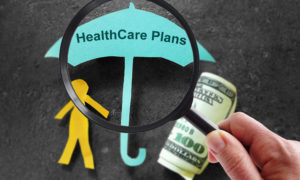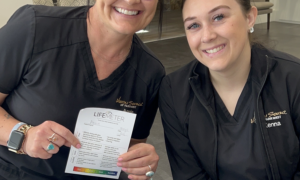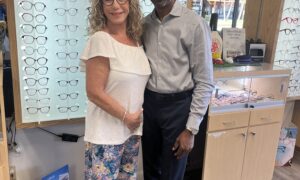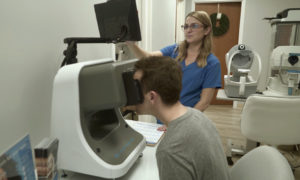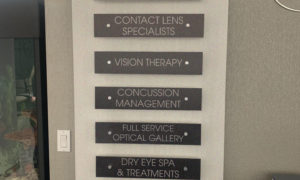
Mattei with Julie Helmus, OD, independent practice owner, Helmus Optometry, consultant and CE Lecturer, at Business Builder: Pathways to Success for Modern ECPs presented by Mattei’s company, Akrinos, in NYC March 14, 2024.
Part 2 of a two-part article on sustaining cash flow during a consumer spending slowdown. Click HERE to read part 1.
By Erich H. Mattei, MBA
April 24, 2024
Patients coming into your office these days may be less likely to spend money than they were a year ago.
According to a recent Wall Street Journal survey of business and academic economists, recession is highly unlikely in 2024. However, the National Retail Federation is calling for a consumer spending slowdown in 2024, speculation bolstered by the results of the New York Federal Reserve’s latest Survey of Consumer Expectations, the Household Spending Survey.
How can your practice adapt to thrive in these uncertain times? In part 1 of this series, I explained the importance of balancing your budget, taking a closer look at operations and improving your inventory management. Now I will delve into four more ways you can sustain cash flow.
Prioritize Revenue Channels
Analyze financial and production reporting to identify the strongest revenue channels (business units or profit centers) for your practice. Evaluate a variety of metrics including patient volume, capture rate in your optical and in patients agreeing to treatments you prescribe, your profitability (margin) and days in accounts receivables (See Reel in Receivables below).
Monitor revenue by practice channel to understand the contribution of each area of your practice to overall financial performance, identifying high-performers, such as profitable optical products and services, opportunities for growth (new products and services you could add) and those products and treatments you are losing money on.
You can use a calculation known as contribution margin to determine how a specific service or product contributes to the overall profits of the practice. Contribution margin identifies the profitability of each specific product or service being provided by the business.
Contribution Margin = Sales Channel Revenue – Variable Expense of Sales Channel, identifying the profit potential of the respective sales channels across your business.
After crunching the numbers, prioritize your availability and resources to serve those patients and channels—patient segments, product or services, managed care carrier, etc.—that are convertible and offer the highest contributions to overall profit of the practice.
Reel in Receivables
Accounts receivable is the balance of money due for goods or services delivered. The longer an invoice remains delinquent, the less likely your practice will be able to collect on it.
According to Dun & Bradstreet, A/R that are 90 days past due have a 69 percent chance of being collected, dropping to 52 percent after six months, and a mere 22 percent after one year of delinquency. Accelerating collection of receivables drives cash flow into your business.
Other Articles to Explore
“Accounts receivable aging” categorizes accounts receivables according to the length of time the invoice has been outstanding (typically in 30-day increments). Identifying the trends in your accounts receivables empowers a proactive strategy to collect what is owed to your practice minimizing AR risk, or the possibility you will not be able to collect the money that is owed to you.
Sort your accounts receivable aging of open accounts in order of invoice date, organized as current (past due less than 30 days), 60 days, 90 days and so on. Seek out collections on open accounts from the aging report in reverse order (target current balances first!), utilizing software as a service (SaaS) bill pay solutions (See Be Accessible below), outbound phone calls, mailers, etc.
Evaluate the role of payors (patients and managed care) that are chronically late payers and consider establishing new payment protocols to minimize accounts receivables or ceasing business relationships with these parties.
Lastly, the complexities of managed care and reimbursements have spurred the growth of medical billing services. Depending on your practice’s A/R and operating procedures, a medical billing service may have significant impact on your business’ cash flow by increasing collections and reducing expenses.
Pro tip: A simple measure of your practice’s A/R effectiveness is accounts receivable turnover.
Accounts Receivable Turnover = Net Credit Sales (any outstanding dollars not collected today, most notably those coming form third-party payor) / Average Accounts Receivable, providing a ratio of the number of times receivables are converted to cash.
A high ratio indicates efficient collection practices, while a lower ratio indicates lower efficiency in collection. Utilize this measure to compare your practice’s A/R effectiveness over time as you implement your A/R strategy.
Cash Reserves & Debt Repayments
Small businesses like optometric practices should maintain 3-6 months of their expenses in cash reserves. This means 3-6 months operating expenses: payroll, occupancy, utilities, software and any other expenses incurred to maintain operations (COGS is not included as not operating expense, but be sure to pay your suppliers in the same period sales are made!)
The importance of maintaining these balances is even more important in uncertain times.
An effective approach to assessing the health of cash holdings in your practice is analyzing your 12-month trailing budget (See Balance Your Budget & A Closer Look at Operations in part 1). To do this, utilize financial and bank statements and customizable reports exportable from your accounting software, comparing expenses to average cash reserves over a specified time period.
If your practice’s bookkeeping utilizes a modern optometric chart of accounts, and records are accurately maintained, you will find the process of identifying these opportunities in your budget and cash reserves is simple math.
However, finding ways to increase savings may present challenges in the degree to which expenses can be carried over is limited (and carrying over expenses may be inadvisable), with the exception of managing debt repayment. The idea here is to balance debt without depleting cash. For example, floating a line of credit with favorable terms if those funds would be better spent elsewhere.
It is vital to balance payment of debts to avoid depleting cash reserves. To optimize your debt repayment plan, analyze the payments and terms of outstanding debts of the practice, then prioritize repayments paying down high interest debts first. Consider negotiating with creditors for lower interest rates if possible, and exploring options to consolidate debts and refinance business loans for more attractive rates (lower payments!).
Lastly, establishing a business line of credit gives your practice access to a revolving line of credit. These funds may be drawn against when needed and offer flexible repayment terms providing leverage, positioning you to maintain adequate cash reserves month-to-month.
Pro tip: Use caution when taking on new debt for your practice assessing costs, payments and terms, ensuring this is not a short-term fix to bigger cash flow issues within your business.
Be Accessible to Patients
According to The Vision Council’s 2023 Q4 Market Insights Report, year-end 2023 saw an increase in prescription eyewear purchases under $100 and a decrease in those purchases over $200.
Your practice’s accessibility to patients has significant implications for your production and cash flow. For starters, consider patient perception of your offerings. Why do patients seek your professional services, but decline your optical offerings? One reason may be that patients perceive your optical as only offering premium or luxury items (See Demand Elasticity & Your Practice in part 1).
Assess communications across the patient journey and marketing to identify opportunities, and consider injecting messaging such as, “the best quality eyewear for any budget,” or other language to engage cost-conscious patients to shop your optical.
Another way your practice can become more accessible is to meet patients and consumers where they are: in digital! There are plethora of SaaS solutions that can make your practice and optical fully accessible to your patients and community, and simplify how patients can do business with your practice.
Offering patient financing solutions also can make your practice more accessible. Options to give patients include CareCredit, Sunbit, Cherry Financing and Klarna.
Consumer spending in 2024 is projected to slowdown, but that doesn’t mean cash flow through your business has to! Taking a proactive approach to analyzing and optimizing your practice across key areas—budget, operations, inventory, revenue, A/R, debt and accessibility—will position your practice for financial stability and growth.
 Erich H. Mattei, MBA, is President and Chief Vision Officer of Akrinos. His mission is to make the business of eyecare approachable, accessible and profitable. In so doing, he consults with private practices across North America, provides strategic advisory to some of the biggest names and hottest start-ups in eyecare, and empowers modern ECPs as a continuing education and keynote speaker. To contact him: erich@akrinos.com
Erich H. Mattei, MBA, is President and Chief Vision Officer of Akrinos. His mission is to make the business of eyecare approachable, accessible and profitable. In so doing, he consults with private practices across North America, provides strategic advisory to some of the biggest names and hottest start-ups in eyecare, and empowers modern ECPs as a continuing education and keynote speaker. To contact him: erich@akrinos.com

